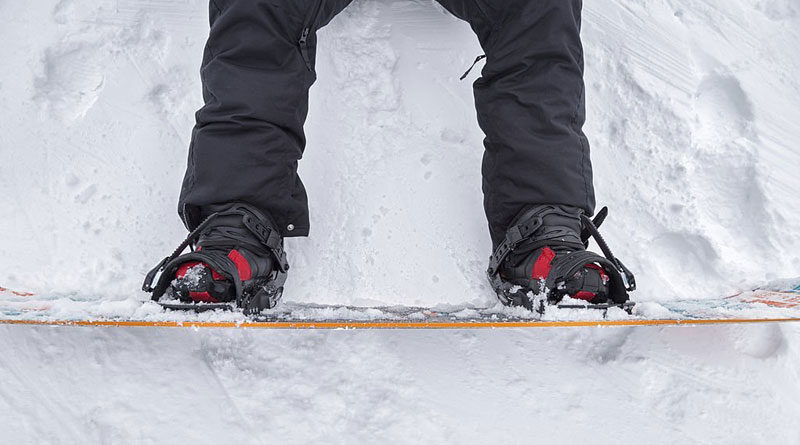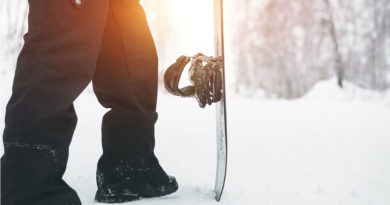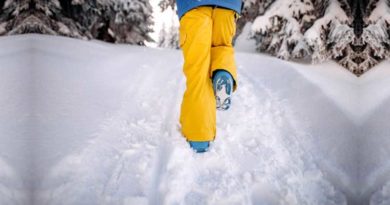Snowboard Bindings too Big? Here’s what to Do
The size of your bindings is determined by the size of your foot and boot. For example, if you choose size medium bindings, you will only be able to fit boot sizes 7 to 9. So, if you have big feet and your bindings are too big for your board, your heel or toe will likely be overhanging the edge of the snowboard. This results in either heel or toe drag. You will experience the drag even more during a turn because your board is put on its edge and the toe or heel will likely be touching the snow. This can be a very bad experience and you want to avoid it at any cost. To prevent this problem, you may opt for a wider board. But, it’s more than just choosing a wider board. Keep reading to learn more.
Measure your foot
Before purchasing your board, bindings, and boots, it is a good idea to measure your foot first for an ideal fit and combination. The measurement should be done barefoot for accurate results. The foot measurement for snowboarding boots includes two parameters; your foot length and width.

- Length: To measure the length of your foot, kick your heel against a wall and mark the floor exactly at the tip of your toe. Now, measure the length between the mark and the wall. Keep your measurements in centimeters. This length is called the Mondo-point and it is the only measurement that you will use when choosing your boots.
- Width: The width is used when you have wide feet and you need special wide boots. To measure the width, place the inside (medial side) of your foot against a wall and mark the floor where the widest point on the lateral (outside) of your foot ends. Now, measure the length between the mark and the wall.
Now use this table to find out the right size.
Choose your boots & bindings
Now you know your foot size, it’s time to get the right boots and bindings. Choosing snowboard boots is now very straightforward because you know your size exactly. Keep in mind that if you have wide feet, it’s better to try the boot before purchasing. If you have the luxury of being able to go into a store, try on different sizes from different brands, and make sure the pair you choose fits you well. Learn more about how snowboard boots should fit here.
Snowboard bindings also come in different sizes from small to x-large and it depends on the company. Between companies, there will be a little difference in sizing but most bindings are adjustable and they have very similar size ranges.
There can also be some overlapping in sizing. For example, small goes from 4 to 8, and medium goes from 7 to 9. If you are size 8, what bindings should you get? Small or Medium? And the answer is, yes. Basically, you will fit in both of them. With the small, you are just going to adjust the straps all the way out and when you mount the bindings, you are going to slide it all the way back. If you go with the medium, you are going to do the exact opposite. At the end of the day, it doesn’t matter which of those sizes you get.
Now, whatever size boot you have, you can correspond that to the binding by using the table below.
| BOARD TYPE | BOARD WIDTH (MM) | SUPPORTED BINDINGS | BOOTS SIZE (MEN’S US) |
|---|---|---|---|
| Narrow | 240-245 | Small | 4-8 |
| Regular | 245-255 | Medium | 8-10.5 |
| Mid-Wide | 255-265 | Large | 10.5-12 |
| Wide | 265+ | X-Large | 12+ |
Mount your bindings to the board
Unless you are a size US 11 or larger, no special or wide board is required. If you’ve got a regular width board, you’ll do just fine. Regular boards range from 245 to 255 mm waist width. This width will fit boots/bindings up to US 10 size. Just make sure your bindings are compatible with your board. The compatibility mainly includes discs or bolts found on the base plates on your bindings. These discs or bolts must be compatible with your board so that you can attach them. Most bindings come with multiple base plates, which makes them compatible with most snowboards. Learn more about how to mount bindings to a board here.
Go for a wider board
So if you’ve got big feet, you may need a wide or mid-wide board depending on how big your feet are. Mid-wide boards range from 255 to 265 mm for men and they will fit size large bindings easily. According to the above table, you can fit boots sizes from 10 to 12. If you’ve got even more big feet, then you need a wide board. Boards with waist width higher than 265 mm are categorized as wide boards. These boards are designed for extra-large bindings that can fit boots size 12+. Refer to the table above for bindings and boots size. All these sizes are for US men’s sizes.
But don’t go too wide
Keep in mind that it’s harder to snowboard with a wider board. Wider boards are slower edge to edge. You’ve got a farther distance to travel from one side of the board to the other side of the board. Also, if you don’t have feet big enough to really push the board, it can be really hard. It sometimes feels like you are trying to turn a coffee table. Finally, wider boards have more materials in them and more materials mean more weight. Heavier boards are difficult to maneuver and make jumps and tricks harder. So, try to keep your board as narrow as possible.
Do all boards come in wide sizes?
If you are a big guy with bid feet, you may have a limited number of board choices. That’s because companies offer only longer boards (longer than 185 cm) in wide versions. However, there is still a wide variety of snowboards available in the wide version. So, it will not be very challenging to find a board that suits your need. You may not find your favorite color or design but you will get a model that will get the job done. Check the EVO website to see what snowboards are available in wide versions.
How to reduce heel/toe drag?
If you are still getting heel or toe drag even after doing all the things right, try these techniques and they may help. First, adjust your heel cup and make sure your boot is centered over the footbed so there’s an even amount of toe and heel hanging. Ideally, you want as little overhang as possible. Learn more about how boots should fit in bindings here. Second, you can increase your binding angle to reduce overhang. Make sure you are not increasing the angle too much as it is also changing your riding stance. Finally, if your boots have room to size down, you can get a smaller boot or you can go for a low-profile boot. The Burton Ions are a good example of low profile boot that doesn’t take too much space in your binding.
Conclusion
If your bindings are a little too big for your board, that simply means your board is not wide enough to accommodate your bindings. This results in heel or toe drag when riding especially when making a turn. This can be a very bad experience and it also makes riding harder. The only solution to this problem is to get a board wide enough to accommodate your bindings. You can also adjust your heel cup to center your boots to reduce heel and toe overhang. Finally, changing the binding angle can also make a difference but works only if you are getting a very little heel/toe overhang.




